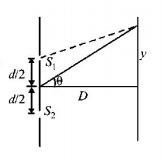Question
In Fresnel's biprism experiment the width of 10 fringes is $$2\,cm$$ which are formed at a distance of 2 meter from the slit. If the wavelength of light is $$5100\,\mathop {\text{A}}\limits^ \circ $$ then the distance between two coherent sources will be
A.
$$5.1 \times {10^{ - 4}}\,m$$
B.
$$5.1 \times {10^{ 4}}\,cm$$
C.
$$5.1 \times {10^{ - 4}}\,mm$$
D.
$$10.1 \times {10^{ - 4}}\,cm$$
Answer :
$$5.1 \times {10^{ - 4}}\,m$$
Solution :

$$d = \frac{{D\lambda }}{\beta }\,......\left( {\text{i}} \right)$$
According to question,
$$\eqalign{ & \lambda = 5100 \times {10^{ - 10}}m \cr & \beta = \frac{2}{{10}} \times {10^{ - 2}}m\,......\left( {{\text{ii}}} \right) \cr & D = 2m,d = ? \cr} $$
From eqs. (i) and (ii)
$$d = \frac{{2 \times 51 \times {{10}^{ - 8}}}}{{2 \times {{10}^{ - 3}}}} = 5.1 \times {10^{ - 4}}m$$

$$d = \frac{{D\lambda }}{\beta }\,......\left( {\text{i}} \right)$$
According to question,
$$\eqalign{ & \lambda = 5100 \times {10^{ - 10}}m \cr & \beta = \frac{2}{{10}} \times {10^{ - 2}}m\,......\left( {{\text{ii}}} \right) \cr & D = 2m,d = ? \cr} $$
From eqs. (i) and (ii)
$$d = \frac{{2 \times 51 \times {{10}^{ - 8}}}}{{2 \times {{10}^{ - 3}}}} = 5.1 \times {10^{ - 4}}m$$